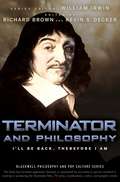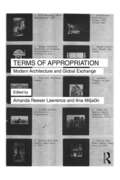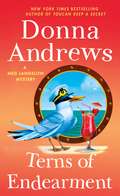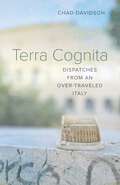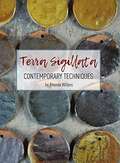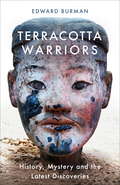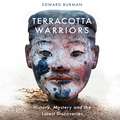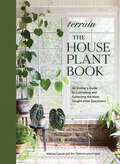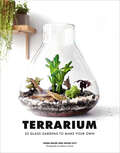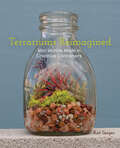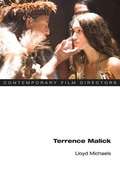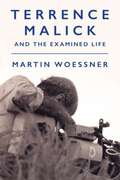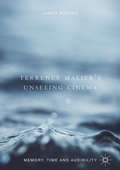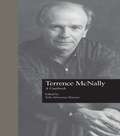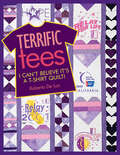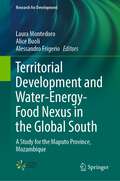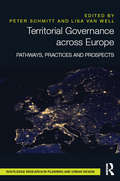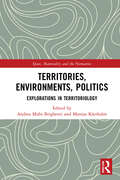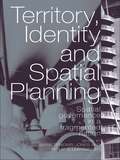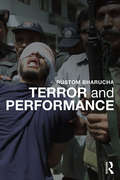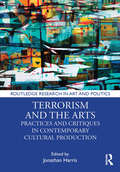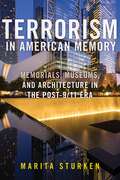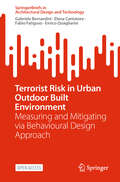- Table View
- List View
Terminator and Philosophy: I'll Be Back, Therefore I Am
by Richard Brown Kevin S. DeckerTime travelers and battles between people and machines provoke old philosophical questions: Can the past really be changed? How do we differentiate ourselves from machines? Can machines have an inner life? Brown (philosophy critical thinking, LaGuardia Community Coll.) and Decker (philosophy, Eastern Washington Univ.; co-editor, Star Wars and Philosophy) collect 19 essays by primarily young academics who pursue these questions with entertaining verve and philosophical skill. The Terminator story is about something well intentioned, a defense project going wrong. Among the book's bright spots are contributions from Harry Chotiner and Jennifer Culver that show us something about how the movies work and explore the feminist issues posed by placing Sarah Connor at the center of the story. One essayist, Phillip Seng, addresses the philosophical trouble at the heart of the tale: telling good from evil in politics is hard.
Terms of Appropriation: Modern Architecture and Global Exchange
by Amanda Reeser Lawrence Ana MiljačkiThis collection focuses on how architectural material is transformed, revised, swallowed whole, plagiarized, or in any other way appropriated. It charts new territory within this still unexplored yet highly topical area of study by establishing a shared vocabulary with which to discuss, or contest, the workings of appropriation as a vital and progressive aspect of architectural discourse. Written by a group of rising scholars in the field of architectural history and criticism, the chapters cover a range of architectural subjects that are linked in their investigations of how architects engage with their predecessors.
Terns of Endearment: A Meg Langslow Mystery (Meg Langslow Mysteries #25)
by Donna AndrewsA new side-splitting Meg Langslow mystery from the award-winning, New York Times bestselling author of Toucan Keep a Secret.Meg Langslow's grandfather has been booked by a cruise line to give lectures on birds and other environmental topics as part of their ship’s education/entertainment itinerary, and Grandfather has arranged for a passel of family members to join him. The passengers’ vacation quickly becomes a nightmare when they wake up to find themselves broken down and in need of repairs in the Bermuda Triangle. To keep the stranded passengers calm, Meg’s family and friends band together to keep things organized and provide entertainment. Some even take up the cause of nursing an injured tern back to health.But things get even worse when a crew member announces to all that a woman has jumped overboard, leaving behind her shoes, shawl, and a note. The note reveals she's the mortal enemy of group of writers who came on board for a retreat, and the group is split on whether suicide is in-character for her. Meanwhile, grandfather’s assistant Trevor seems to have gone missing too! The captain decides not to investigate, saying he'll notify American authorities when they reach their destination. But Meg's father thinks they should find out whether there was foul play while the prime suspects are all stuck on board. Who wanted the writer dead? Why doesn’t the captain seem concerned? What happened to Trevor? It'll be a race against the clock to solve these mysteries before they make the necessary repairs and return to shore.Terns of Endearment is the twenty-fifth book in New York Times bestselling author Donna Andrews' hilarious Mag Langslow mystery series.
Terra Cognita: Dispatches from an Over-Traveled Italy
by Chad DavidsonTwenty-seven years in the making, Terra Cognita chronicles the author’s continual travels—and problematic (if still, at times, ecstatic) encounters—in the “bel paese.” Across nine richly evocative essays, Chad Davidson investigates the seemingly never-ending fascination that travelers have with Italy.As much a meditation on what home and away mean as it is a travel memoir, Terra Cognita finds literary predecessors such as Dante and Italo Calvino crowding in alongside more accustomed sights from travel shows, Hollywood films, and tourist guides. Though each essay departs from a particular location in Italy and remains rooted in the author’s own history there, the book ultimately becomes less about those places and more about the placelessness any such journey can engender, how—even after flying across an ocean and landing in a foreign country—we are still hopelessly and fully ourselves.
Terra Sigillata: Contemporary Techniques
by Rhonda Willers American Ceramic Society StaffIn Terra Sigillata: Contemporary Techniques, Rhonda Willers provides an historical overview, as well as technical information on how to make, mix, and apply terra sigillatas. In addition, she presents contemporary artist profiles and techniques to enrich and encourage your terra sigillata development. This book is loaded with techniques. Twelve Process sections featuring illustrated, step-by-step instruction on making, siphoning, and blending terra sigillatas. In addition, you ll find 33 Try It Like sections featuring artist profiles of contemporary ceramic artists explaining how they use and create terra sigillatas for their work.
Terracotta Warriors: History, Mystery and the Latest Discoveries
by Edward BurmanTerracotta Warriors provides an intriguing, original and up-to-date account of one of the wonders of the ancient world. Illustrated with a wealth of original photographs, this is the first book available for the general reader. In one of the most astounding archaeological discoveries of all time, the Terracotta Warriors were discovered by chance by farmers in 1974. We now understand that the excavated pits containing nearly eight thousand warriors and hundreds of horses are only part of a much grander mausoleum complex. There is a great deal still to be discovered and understood about the entire area whichis now thought to cover around 100 square kilometres. And there is the tantalising possibility of the opening of the imperial tomb.
Terracotta Warriors: History, Mystery and the Latest Discoveries
by Edward BurmanTerracotta Warriors provides an intriguing, original and up-to-date account of one of the wonders of the ancient world. Illustrated with a wealth of original photographs, this is the first book available for the general reader. In one of the most astounding archaeological discoveries of all time, the Terracotta Warriors were discovered by chance by farmers in 1974. We now understand that the excavated pits containing nearly eight thousand warriors and hundreds of horses are only part of a much grander mausoleum complex. There is a great deal still to be discovered and understood about the entire area whichis now thought to cover around 100 square kilometres. And there is the tantalising possibility of the opening of the imperial tomb.
Terracotta Warriors: History, Mystery and the Latest Discoveries
by Edward BurmanTerracotta Warriors provides an intriguing, original and up-to-date account of one of the wonders of the ancient world. Illustrated with a wealth of original photographs, this is the first book available for the general reader which incorporates the most recent excavations, new theories and discoveries. In one of the most astounding archaeological discoveries of all time, the Terracotta Warriors were discovered by chance by farmers in 1974. We now understand that the excavated pits containing nearly eight thousand warriors and hundreds of horses are only part of a much grander mausoleum complex. There is a great deal still to be discovered and understood about the entire area whichis now thought to cover around 100 square kilometres. And there is the tantalising possibility of the opening of the imperial tomb.With unique access to the leading Chinese archaeologists and historians - including the full support of the Shaanxi Provincial Cultural Relics Bureau, responsible for all archaeological sites and museums in the province - Burman is able to guide us through the ancient Chinese concept of longevity and the afterlife, essential to understand the mausoleum. We can see as never before how the Terracotta Warriors strongly represent the fascinating circumstances in which they lived.Read by Roger Davis(p) 2018 Orion Publishing Group
Terrain: An Insider's Guide to Cultivating and Collecting the Most Sought-After Specimens
by Melissa Lowrie&“An informative and inspiring guide to collecting and growing plants at home.&”—Gardenista &“This book is a must-have!&”—Hilton Carter, author of Wild at Home, Wild Interiors, and Wild CreationsSecrets of the Houseplant Hunters Terrain&’s plant experts travel the world in search of the most unusual and interesting houseplants. In this inspiring and practical guide, they share their favorite specimens: exotic and eclectic ferns, like the skeleton fork, a primitive (and unfussy) predecessor to the family; new aroids to feed that monstera obsession; and adventurous trailing plants like dischidia, which is found cascading from tree branches in its native Thailand; plus succulents and cacti, indoor trees, the best low-care plants, and &“rule breakers&” like bamboo muhly grass that can make an unexpected move indoors. Along the way, Terrain introduces their favorite independent growers—passionate plant lovers who are creating new hybrids and bringing back old-school specimens to the market. And readers learn Terrain&’s way of styling and overarching philosophy on care: the most important thing we can give our plants is our presence.
Terrarium Craft: Create 50 Magical, Miniature Worlds
by Kate Baldwin Amy Bryant Aiello Kate BryantA terrarium is nothing less than a miniature world—one that you can create yourself. It might be a tiny rainforest, with lush foliage and bright tropical flowers. Or a desert, with strange succulents planted among colorful stones. Or a Victorian fernery. Or a minimalist composition with a single, perfect plant.Or it might not contain any plants at all. It might be made with crystals, feathers, bones, seashells, bits of wood, porcelain trinkets—anything that catches your fancy and helps create a mood or look. Whatever they contain, terrariums are the ultimate in modern, affordable, easy-care décor.Terrarium Craft features fifty original designs that you can re-create or use as inspiration for your own design. Each entry comes with clear step-by-step directions on how to assemble and care for your terrarium. You’ll also find helpful information about selecting a container, using appropriate materials, choosing the right plants, and maintaining your terrarium. (Hint: It’s easy! In fact, many terrariums are self-sustaining, requiring no maintenance whatsoever!)
Terrarium: 33 Glass Gardens to Make Your Own
by Anna Bauer Noam LevyA comprehensive guide to creating unusual and beautiful miniature indoor gardens, including thirty-three simple projects. Easy to make, these thirty-three unique terrarium projects are inspired by ecosystems around the world, including a fern-filled Black Forest from Germany, a delicate bonsai garden from Kyushu in the south of Japan, and a tableau of olive and thyme from the shores of the Sea of Galilee in Israel. Lush photography and helpful insider tips and tricks round out this one-of-a-kind handbook. With a variety of projects and plenty of step-by-step instructions covering every element of crafting a terrarium, anyone can fashion a stunning piece of living art.
Terrariums Reimagined: Mini Worlds Made in Creative Containers
by Kat GeigerCREATE ADORABLE GARDENS IN INGENIOUS VESSELS <P><P>Add style, nature and a touch of whimsy to your home with one-of-a-kind terrariums. <P><P>Terrariums Reimagined shows how to make and maintain arid deserts, flowering jungles and lush landscapes in unique containers, such as:* Milk Bottle* Mason Jar* Tea Pot* Wine Bottle* Light Bulb* Glass Soda Bottle* Decorative Vase* Whiskey Bottle <P><P>Author Kat Geiger's unique approach to designing mini gardens in glass makes it easy to turn imaginative ideas into stylish showpieces, blooming decor and fabulous gifts. <P><P>This book provides everything you need to know about making terrariums, whether you're a novice or an expert, including step-by-step photos, helpful gardening advice, and tips and tricks on how to find the perfect repurposed vessels for your creations.
Terrence Malick (Contemporary Film Directors)
by Lloyd MichaelsFor a director who has made only four feature films over three decades, Terrence Malick has sustained an extraordinary critical reputation as one of America's most original and independent filmmakers. In this book, Lloyd Michaels analyzes each of Malick's four features in depth, emphasizing both repetitive formal techniques such as voiceover and long lens cinematography as well as recurrent themes drawn from the director's academic training in modern philosophy and American literature. Michaels explores Malick's synthesis of the romance of mythic American experience and the aesthetics of European art film. He performs close cinematic analysis of paradigmatic moments in Malick's films: the billboard sequence in Badlands, the opening credits in Days of Heaven, the philosophical colloquies between Witt and Welsh in The Thin Red Line, and the epilogue in The New World. This richly detailed study also includes the only two published interviews with Malick, both in 1975 following the release of his first feature film.
Terrence Malick and the Examined Life (Intellectual History of the Modern Age)
by Martin WoessnerTerrence Malick is one of American cinema’s most celebrated filmmakers. His films—from Badlands (1973) and Days of Heaven (1978) to The Thin Red Line (1998), The Tree of Life (2011), and, most recently, A Hidden Life (2019)—have been heralded for their artistry and lauded for their beauty, but what really sets them apart is their ideas. Terrence Malick and the Examined Life is the most comprehensive account to date of this unparalleled filmmaker’s intellectual and artistic development.Utilizing newly available archival sources to offer original interpretations of his canonical films, Martin Woessner illuminates Malick’s early education in philosophy at Harvard and Oxford as well as his cinematic apprenticeship at the American Film Institute to show how a young student searching for personal meaning became a famous director of Hollywood films. Woessner’s book presents a rich, interdisciplinary exploration of the many texts, thinkers, and traditions that made this transformation possible—from the novels of Hamlin Garland, James Jones, and Walker Percy to the philosophies of Stanley Cavell, Martin Heidegger, and Søren Kierkegaard to road movies, Hollywood Westerns, and the comedies of Jean Renoir. Situating Malick’s filmmaking within recent intellectual and cultural history, Woessner highlights its lasting contributions to both American cinema and the life of the mind.Terrence Malick and the Examined Life suggests it is time for philosophy to be viewed not merely as an academic subject, overseen by experts, but also as a way of life, open to each and every moviegoer.
Terrence Malick’s Unseeing Cinema: Memory, Time And Audibility
by James BatchoThis unique study opens up a new dimension of Terrence Malick’s cinema – its expressions of unseeing and hearing. ‘Unseeing’ is Malick’s means of transcending the moment in order to enter the life that unfolds; to treat cinema as a real experience for those who live its reality. In this way, Terrence Malick’s Unseeing Cinema moves beyond film theory to advance a work of original philosophy, bringing together two thinkers not normally associated with one another: Gilles Deleuze and Søren Kierkegaard. It investigates how Malick’s gatherings of time allow one to explore new philosophical questions about immanence and transcendence, ethics and faith, time and infinity, and the foldings of subjectivity that are central to both philosophers. Beyond cinema, it offers a way to think about our everyday repetitions and recollections and our ephemeral points of connection with those we love.
Terrence McNally: A Casebook (Casebooks on Modern Dramatists #No. 22)
by Toby Silverman ZinmanFirst Published in 1997. Routledge is an imprint of Taylor & Francis, an informa company.
Terrific Tees: I Can't Believe It's A T-shirt Quilt!
by Roberta De LuzGive new life to favorite T-shirts by making them into quilts you'll be proud to display or give.
Territorial Development and Water-Energy-Food Nexus in the Global South: A Study for the Maputo Province, Mozambique (Research for Development)
by Alessandro Frigerio Laura Montedoro Alice BuoliThis volume collects the results from the Politecnico di Milan’s award-winning “Boa_Ma_Nhã, Maputo!” research-by-design project, which studied various transdisciplinary approaches to development in the context of the Global South. The challenges of urbanization are well known, but that only goes so far in aiding implementation. From local considerations like water access and housing rights to global issues like climate change, territorial development demands solutions that address the needs of the specific population while keeping such goals as sustainability and inclusion in mind. By focusing on a number of towns within the Maputo Province of Mozambique, and thus addressing many of the issues endemic to Sub-Saharan Africa, the research, structurally presented so as to aid those who may require introduction to the issue, makes a clear case in favor of always keeping the Water-Energy-Food (WEF) Nexus in mind when formulating development strategies for improving people’s lives, as well as the wisdom of marrying academic findings with the insights accrued by local NGOs and institutions, thereby expanding the potential idea bank beyond the Eurocentric status quo that has tended to dominate the field.
Territorial Governance across Europe: Pathways, Practices and Prospects
by Peter Schmitt Lisa Van WellThis book provides a comprehensive framework for analysing, comparing and promoting territorial governance in policy relevant research. It reveals in-depth considerations of the emergence, state-of-the art and evolution of the concept of territorial governance. A unique series of ten case studies across Europe, from neighbourhood planning in North Shields in the North East of England to climate change adaptation in the Baltic Sea Region, provides far-reaching insights into a number of key elements of territorial governance. The book draws generalised empirically-based conclusions and discusses modes of transferability of ‘good practices’. A number of suggestions are presented as to how the main findings from this book can inform theories of territorial governance and spatial policy and planning. Territorial Governance across Europe will be of considerable interest to scholars around the world who are concerned with European studies, regional policy, urban and regional planning, and human and political geography. It provides a solid debate on discourses, theories, concepts and methods around the notion of territorial governance as well as a number of empirical findings from various contexts across Europe. It specifically targets scholars involved in policy-relevant research.
Territories, Environments, Politics: Explorations in Territoriology
by Andrea Mubi BrighentiThis collection seeks to illustrate the state of the art in territoriological research, both empirical and theoretical. The volume gathers together a series of original, previously unpublished essays exploring the newly emerging territorial formations in culture, politics and society. While the globalisation debate of the 1990s largely pivoted around a ‘general deterritorialisation’ hypothesis, since the 2000s it has become apparent that, rather than effacing territories, global connections are added to them, and represent a further factor in the increase of territorial complexity. Key questions follow, such as: How can we further the knowledge around territorial complexities and the ways in which different processes of territorialisation co-exist and interact, integrating scientific advances from a plurality of disciplines? Where and what forms does territorial complexity assume, and how do complex territories operate in specific instances? Which technological, political and cultural facets of territories should be tackled to make sense of the life of territories? How and by what different or combined methods can we describe territories, and do justice to their articulations and meanings? How can the territoriological vocabulary relate to contemporary social theory advancements such as ANT, the ontological turn, the mobilities paradigm, sensory urbanism, and atmospheres research? How can territorial phenomena be studied across disciplinary boundaries? Territories, Environments, Politics casts a fresh perspective onto a number of key contemporary socio-spatial phenomena. Refraining from the attempt to ossify territoriology into some disciplinary straightjacket, the collection aims to illustrate the scope of current territoriological research, its domain, its promises, its theoretical advancements, and its methodological reflection in the making. Scholars interested in social research will find in this collection a rich and imaginative theoretical-methodological toolkit. Students in human geography, anthropology and sociology, socio-legal studies, architecture and urban planning will find Territories, Environments, Politics of interest.
Territory, Identity and Spatial Planning: Spatial Governance in a Fragmented Nation
by Philip Allmendinger Mark Tewdwr-JonesThis book provides a multi-disciplinary study of territory, identity and space in a devolved UK, through the lens of spatial planning. It draws together leading internationally renowned researchers from a variety of disciplines to address the implications of devolution upon spatial planning and the rescaling of UK politics. Each contributor offers a different perspective on the core issues in planning today in the context of New Labour’s regional project, particularly the government’s concern with business competitiveness, and key themes are illustrated with important case studies throughout.
Terror and Performance
by Rustom Bharucha‘This work goes where other books fear to tread. It reaches the parts other scholars might imagine in their dreams but would neither have the international reach nor the critical acumen and forensic flourish to deliver.’ Alan Read, King's College London ‘This book is not only timely. It is overdue – and it is a masterpiece unrivalled by any book I know of.’ Erika Fischer-Lichte, Freie Universität Berlin ‘The first and only book that focuses on the intersections of performance, terror and terrorism as played out beyond a Euro-American context post-9/11. It is an important work, both substantively and methodologically.’ Jenny Hughes, University of Manchester ‘A profound and tightly bound sequence of reflections … a rigorously provocative book.’ Stephen Barber, Kingston University London In this exceptional investigation Rustom Bharucha considers the realities of Islamophobia, the legacies of Truth and Reconciliation, the deadly certitudes of State-controlled security systems and the legitimacy of counter-terror terrorism, drawing on a vast spectrum of human cruelties across the global South. The outcome is a brilliantly argued case for seeing terror as a volatile and mutant phenomenon that is deeply lived, experienced, and performed within the cultures of everyday life.
Terrorism and the Arts: Practices and Critiques in Contemporary Cultural Production (Routledge Research in Art and Politics)
by Jonathan HarrisThis book assesses the key definitions, forms, contexts and impacts of terrorist activity on the arts in the modern era, using historical and contemporary perspectives. Its empirical case studies include theatre, literature, music, visual art, mass media, film and the mores of ‘ordinary life.’ While its immediate reflective context is Islamic fundamentalist terrorism, the book reviews a broader range of definitions and counter-definitions of 'terrorism', 'state terrorism' and 'states of terror,' examining uses of the terms through a series of comparative analyses. Chapters focus on the intersection of these definitional questions with heuristic analysis of art forms, cultural activities and their socio-historical contexts. This book will be of interest to scholars in art history, terrorism, politics and the media, and visual culture.
Terrorism in American Memory: Memorials, Museums, and Architecture in the Post-9/11 Era
by Marita SturkenThe role of cultural memory in American identityTerrorism in American Memory argues that the terrorist attacks of 9/11 and all that followed in its wake were the primary force shaping United States politics and culture in the post-9/11 era. Marita Sturken maintains that during the past two decades, when the country was subjected to terrorist attacks and promulgated ongoing wars of aggression, we have veered into increasingly polarized factions and been extraordinarily preoccupied with memorialization and the politics of memory. The post-9/11 era began with a hunger for memorialization and it ended with massive protests over police brutality that demanded the destruction of historical monuments honoring racist historical figures. Sturken argues that memory is both the battleground and the site for negotiations of national identity because it is a field through which the past is experienced in the present. The paradox of these last two decades is that it gave rise to an era of intensely nationalistic politics in response to global terrorism at the same time that it released the containment of the ghosts of terrorism embedded within US history. And within that disruption, new stories emerged, new memories were unearthed, and the story of the nation is being rewritten. For these reasons, this book argues that the post-9/11 era has come to an end, and we are now in a new still undefined era with new priorities and national demands. An era preoccupied with memory thus begins with the memorial projects of 9/11 and ends with the radical intervention of the National Memorial for Peace and Justice, informally known as the Lynching Memorial, in Montgomery, Alabama, a project that, unlike the nationalistic 9/11 Memorial and Museum in New York, dramatically rewrites the national script of American history. Woven within analyses of memorialization, memorials, memory museums, art projects on memory, and architectural projects is a discussion about design and architecture, the increased creation of memorials as experiences, and the role of architecture as national symbolism and renewal. Terrorism in American Memory sheds light on the struggles over who is memorialized, who is forgotten, and what that politics of memory reveals about the United States as an imaginary and a nation.
Terrorist Risk in Urban Outdoor Built Environment: Measuring and Mitigating via Behavioural Design Approach (SpringerBriefs in Architectural Design and Technology)
by Gabriele Bernardini Fabio Fatiguso Enrico Quagliarini Elena CantatoreThis open access book outlines the latest results in analysing, assessing, and managing terrorist risk in the urban outdoor built environment. In detail, contents refer to the outdoor Open Areas (such as streets, squares, urban parks and other public spaces in our cities) exposed to such violent events considering the physical elements and properties of the built environment and users. PThe built environment features, including layout, use and management, are combined with terrorist threats issues and user behaviours in emergency conditions, to determine a set of complementary tools for the reduction of risk and increase of urban resilience. The contents hence provide different levels of tool analysis, for risk scenario definition, risk assessment, mitigation strategies design and effectiveness evaluation, considering traditional approaches about the issue along with simulation-based approaches relying on understanding and representing user behaviors. This “behavioural design” approach offers the opportunity to manage the level of risk for specific real urban cases over going the normative limitations in Europe that are only referred to few countries and sometimes deal with the prevention of violent acts by intelligence activities as the exclusive way to face this issue. In addition, the focus on the characters of cultural and historic places and their resilience is increasing by means of introduction of mitigation and compatible solutions providing a complementary chapter for the design of resilient cities in all of their peculiarities (peripheries, consolidated, and historical). In this sense, it is one of the first organized attempts to analyse the main limitations of current solutions in these outdoor Open Areas and, at the same time, to clearly introduce the importance of human behaviours and the various choices in emergency evacuation conditions, thanks to the proposed behavioural-based simulation approach. The attention is focused on a critical aspect for historic spaces, where morphological conditions are fixed values. Thus, this book represents a sort of guidelines about these user-related issues during such violent events and is useful to both professionals and researchers in the areas of security and urban administration.
